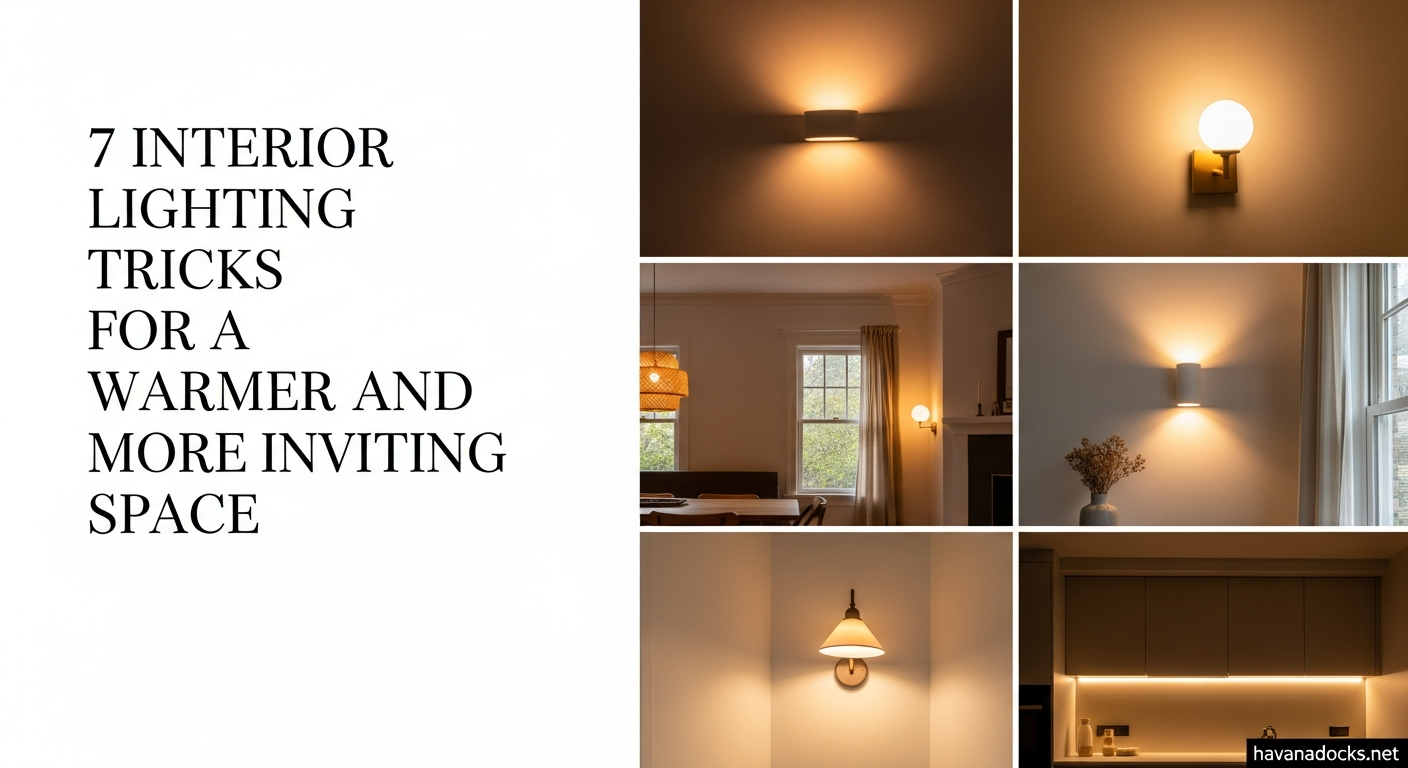Understanding the Power of Layered Lighting
7 Interior Lighting – Layered lighting is the foundation of any well-lit space. It involves using a combination of different types of light sources to create a balanced and visually appealing effect. This approach avoids the pitfalls of relying solely on one type of lighting, which can often result in a flat and uninteresting atmosphere. The best interior lighting tricks take advantage of layered lighting.
Ambient Lighting: Setting the Foundation
Ambient lighting, also known as general lighting, provides overall illumination to a room. It fills the space with a soft, even glow. It is often the first layer considered in a lighting design. Common sources of ambient light include:
- Overhead fixtures (chandeliers, pendant lights, flush mounts)
- Recessed lighting
- Wall sconces that cast light upwards as well as downwards.
The goal of ambient lighting is to ensure you can move around the room comfortably and safely. Dimmers are helpful on ambient lights so you can easily change the mood.

Task Lighting: Illuminating Specific Activities
Task lighting focuses light on specific areas where you perform tasks, like reading, cooking, or working. It’s essential for functionality and prevents eye strain. Examples of task lighting include:
- Desk lamps
- Under-cabinet lighting in the kitchen
- Reading lamps next to a chair or bed
- Vanity lights in the bathroom
Choose task lighting that provides focused, bright light without glare. Adjustable arms or shades can help direct the light exactly where you need it. The strategic placement of task lighting is one of the most practical interior lighting tricks.
Accent Lighting: Highlighting Key Features
Accent lighting adds drama and interest by highlighting specific features, such as artwork, architectural details, or plants. It creates visual focal points and adds depth to a room. Sources of accent lighting include:
- Spotlights
- Track lighting
- Picture lights
- Uplighting
Accent lighting should be three times brighter than the ambient lighting to create a noticeable contrast. Careful aiming is critical to avoid glare. It is also one of the easiest interior lighting tricks to implement.
7 Interior Lighting Tricks for a Warmer and More Inviting Space
Here are seven actionable tips for implementing interior lighting tricks and making your space feel more welcoming and cozy:
1. Embrace Warm-Toned Light Bulbs
The color temperature of your light bulbs greatly influences the ambiance of a room. Cool-toned bulbs (with a higher Kelvin rating) emit a blueish light that can feel harsh and sterile. Warm-toned bulbs (with a lower Kelvin rating) emit a yellowish light, creating a cozy and inviting atmosphere.
- Choose bulbs with a Kelvin rating between 2700K and 3000K for living rooms, bedrooms, and dining areas.
- Opt for cooler-toned bulbs (3500K – 4000K) in areas where you need bright, focused light, such as kitchens and home offices.
- Consider using smart bulbs that allow you to adjust the color temperature throughout the day, mimicking natural light.
Switching to warm-toned bulbs is one of the simplest and most effective interior lighting tricks to transform your space.
2. Dimmers are Your Best Friend
Installing dimmers on your light fixtures gives you complete control over the intensity of the light, allowing you to create different moods. You can dim the lights for a relaxing evening or brighten them for tasks that require more focused light.
- Install dimmers on overhead fixtures, table lamps, and wall sconces.
- Consider using smart dimmers that can be controlled with your smartphone or voice assistant.
- Use dimmers to create a cozy ambiance during movie nights or dinner parties.
Dimmers are an essential tool for creating a versatile and inviting space. Mastering light control is an essential aspect of interior lighting tricks.
3. Uplighting to Create Height and Drama
Uplighting involves placing light fixtures on the floor or behind furniture to cast light upwards onto the walls and ceiling. This technique creates a sense of height and drama, making the room feel larger and more inviting.
- Place uplights behind plants to highlight their foliage and create interesting shadows.
- Use uplights to illuminate architectural features, such as fireplaces or textured walls.
- Position uplights in corners to soften the edges of the room and create a more inviting atmosphere.
Uplighting is a simple yet effective way to add depth and dimension to your space. When it comes to interior lighting tricks, consider the shadows!
4. Incorporate Table and Floor Lamps
Table and floor lamps are excellent sources of both task and ambient lighting. They add a layer of warmth and coziness that overhead fixtures often lack.
- Place table lamps on side tables, desks, and consoles to provide task lighting and add a decorative touch.
- Use floor lamps next to chairs and sofas to create a reading nook.
- Choose lamps with shades that complement your décor and diffuse the light for a softer glow.
- Ensure the height of the lamps is appropriate for the task at hand. For example, a reading lamp should be tall enough to direct light over your shoulder onto the page.
The gentle glow of table and floor lamps contributes significantly to creating a warm and inviting atmosphere. This classic choice is at the heart of many interior lighting tricks.
5. String Lights for Whimsical Ambiance
String lights are no longer just for the holidays. They offer a charming and whimsical way to add warmth and character to your space.
- Drape string lights across a headboard or along a wall to create a cozy and romantic ambiance.
- Hang string lights on a balcony or patio to create an inviting outdoor space.
- Use string lights to highlight a gallery wall or create a focal point in a room.
- Look for string lights with different bulb shapes and sizes to add visual interest.
String lights are an affordable and versatile way to add a touch of magic to any room. They are fun and a great addition to your toolbox of interior lighting tricks if you want a casual, relaxed feel.
6. Mirrors to Maximize Natural Light
Mirrors not only make a room appear larger but also reflect and amplify natural light, brightening the space and creating a more open and airy feel.
- Place a large mirror opposite a window to maximize the amount of natural light in the room.
- Hang mirrors on walls to reflect light and create the illusion of more space.
- Use mirrored furniture, such as coffee tables or side tables, to add a touch of glamour and reflect light.
Strategic placement of mirrors is a simple yet powerful way to enhance the natural light in your home. This is a great way to implement interior lighting tricks without adding more fixtures!
7. Embrace Candles and Lanterns
Candles and lanterns offer a warm, flickering light that creates a relaxed and intimate atmosphere. They’re perfect for adding a touch of romance or creating a cozy setting for a dinner party.
- Group candles of varying heights and sizes on a table or mantel for a visually appealing display.
- Use lanterns to create a warm glow on a porch or patio.
- Choose scented candles to add a pleasant fragrance to the room.
- Always exercise caution when burning candles and never leave them unattended.
The soft glow of candles and lanterns adds a touch of magic to any space. While technically not electric, they provide much the same effect that makes many interior lighting tricks so compelling.

Choosing the Right Fixtures: Style and Functionality
Choosing the right light fixtures involves balancing style and functionality. The fixtures should complement your décor while providing the necessary illumination for the space.
Style Considerations: Matching Your Aesthetic
The style of your light fixtures should align with the overall aesthetic of your home.
- Modern: Opt for sleek, minimalist fixtures with clean lines.
- Traditional: Choose ornate fixtures with classic details.
- Bohemian: Incorporate eclectic fixtures with unique shapes and textures.
- Farmhouse: Select rustic fixtures with vintage-inspired designs.
Consider the finish of the fixtures as well. Common finishes include brushed nickel, polished chrome, oil-rubbed bronze, and matte black. Think about what materials and colors will best complement your existing decor. The subtle aspects of fixture choice are a detail that elevates many interior lighting tricks.
Functional Requirements: Meeting Your Needs
Consider the functional requirements of each room when choosing light fixtures.
- Kitchen: Prioritize task lighting under cabinets and over countertops.
- Bathroom: Choose vanity lights that provide even illumination for grooming.
- Living room: Incorporate a mix of ambient, task, and accent lighting for different activities.
- Bedroom: Focus on creating a relaxing atmosphere with soft, warm lighting.
Think about how you use each space and what type of lighting will best support your needs. Task lighting is essential in workspaces, while ambient lighting is more crucial in relaxation areas. Considering functionality is integral to successful interior lighting tricks.
Smart Lighting Options
Smart lighting offers advanced control and customization options, allowing you to adjust the color temperature, brightness, and even the on/off schedule of your lights.
- Smart bulbs: These can be controlled with your smartphone or voice assistant. They often offer features like color changing and dimming.
- Smart dimmers: These allow you to dim your lights remotely and can be integrated with smart home systems.
- Smart switches: These can be programmed to turn lights on and off at specific times.
Smart lighting can enhance your comfort and convenience, and also help you save energy.
Energy Efficiency: Choosing the Right Bulbs
Choosing energy-efficient light bulbs can significantly reduce your energy consumption and lower your electricity bills.
- LED bulbs: These are the most energy-efficient option, using up to 75% less energy than incandescent bulbs and lasting much longer.
- CFL bulbs: These are also energy-efficient, but they contain mercury and require special disposal.
Check the Energy Star rating when purchasing bulbs to ensure they meet energy-efficiency standards. Being conscious of energy usage is a responsible way to implement interior lighting tricks.

Advanced Lighting Techniques Beyond the Basics
Once you’ve mastered the basics, you can explore more advanced interior lighting tricks to further enhance your space.
Color Psychology: Using Light to Influence Mood
Color psychology explores how different colors affect our emotions and behavior. You can use colored light bulbs to create different moods in your space.
- Blue light: Promotes relaxation and calmness, ideal for bedrooms and bathrooms.
- Green light: Creates a sense of nature and tranquility, suitable for living rooms and offices.
- Red light: Stimulates energy and excitement, best used sparingly in social spaces.
- Yellow light: Evokes feelings of happiness and optimism, perfect for kitchens and dining areas.
Experiment with different colored light bulbs to see how they affect the mood of your room.
Light Placement for Art Display
Proper lighting is crucial for showcasing artwork and highlighting its beauty.
- Picture lights: These are specifically designed to illuminate paintings and prints.
- Track lighting: This offers flexible lighting options and can be adjusted to highlight different pieces of art.
- Recessed spotlights: These provide focused light without taking up much space.
Ensure the light is directed at the artwork at a 30-degree angle to avoid glare. The angle of the light is critical in effectively incorporating these interior lighting tricks.
Ambient Glow Through Indirect Illumination
Indirect illumination involves bouncing light off of surfaces, such as walls and ceilings, to create a soft, even glow. This technique can be achieved using:
- Cove lighting: This is installed in a recessed area near the ceiling to wash light downwards.
- Wall washers: These are designed to evenly illuminate a wall surface.
- Torchiere lamps: These cast light upwards onto the ceiling.
Indirect illumination is a great way to create a comfortable and relaxing atmosphere.
Conclusion
Creating a warm and inviting space doesn’t require a complete overhaul. By implementing these seven interior lighting tricks, you can transform your home into a cozy and welcoming haven. Remember to embrace layered lighting, choose warm-toned bulbs, and utilize dimmers to create different moods. Incorporate table and floor lamps, string lights, and mirrors to add warmth and character. And don’t forget the magic of candles and lanterns. Experiment and find what works best for your style and needs. By mastering these techniques, you can create a space that is both beautiful and inviting, a place where you truly love to be.





